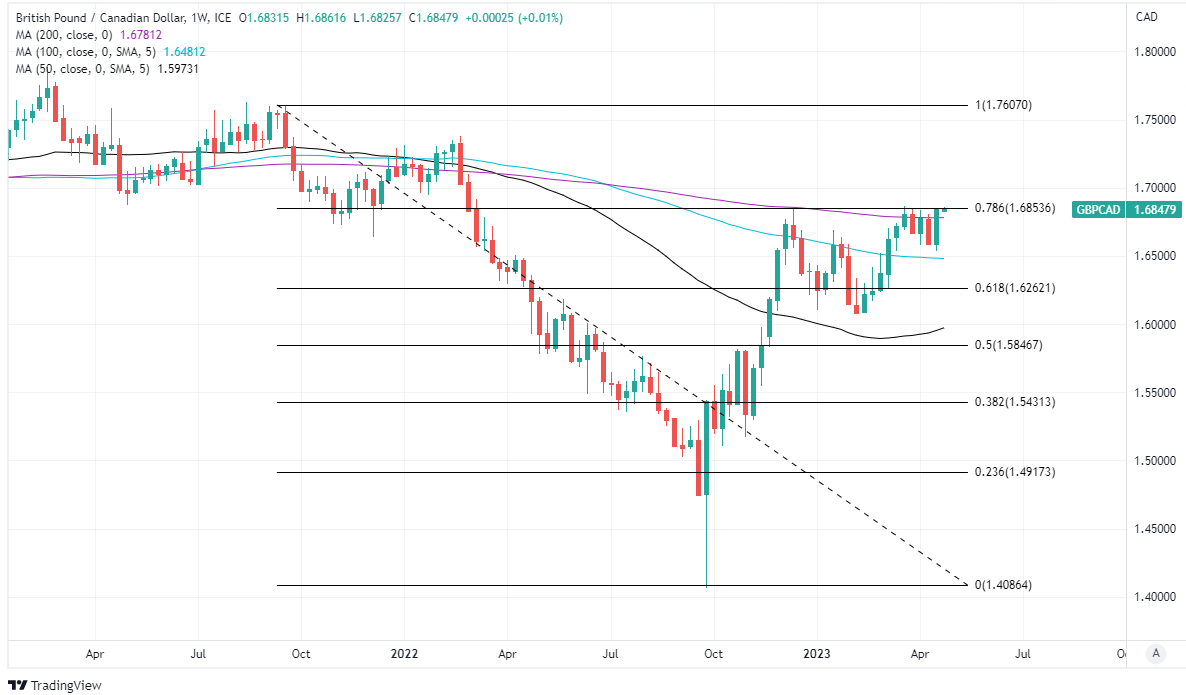GBP/CAD Week Ahead Forecast: Edging Higher as Setback Risk Rises
- Written by: James Skinner
-
- GBP/CAD testing highest levels since Ukraine invasion
- Possible risk or chance of advance to 1.69+ short-term
- UK borrowing data, BoC minutes & CAD GDP in focus

Image © Adobe Stock
The Pound to Canadian Dollar exchange rate entered the new week retesting its recent highs and there may be a risk of it edging above 1.69 if the recent trend persists but Canada's February GDP data is a potential pitfall for Sterling.
Canada's Dollar gave ground to all counterparts in the G10 basket and the vast majority of its peers in the G20 grouping over the week to Monday following declines for commodity prices and a further retrenchment of local inflation rates.
Meanwhile, the Pound came close to the top of the board following a flurry of economic data that has seen financial markets ramp up expectations for the Bank of England (BoE) Bank Rate in the months ahead with market-implied levels nearing 5% for the year-end period.
"Last week’s elevated CPI print prompted us to revise our terminal rate assumption to 4.50%. While we now expect a 12th straight rate hike the market attempted to push terminal rates towards 5.00%," says Bipan Rai, North American head of FX strategy at CIBC Capital Markets.
"We would view any such attempts as overly aggressive despite the fact that BoE insider Dave Ramsden has reiterated that domestic rate pressures remain strong," Rai writes in Monday market commentary.
 Above: Pound to Canadian Dollar rate shown at daily intervals with selected moving averages. Click image for closer inspection. (To optimise the timing of international payments you could consider setting a free FX rate alert here.)
Above: Pound to Canadian Dollar rate shown at daily intervals with selected moving averages. Click image for closer inspection. (To optimise the timing of international payments you could consider setting a free FX rate alert here.)
Tuesday's public finances figures for March are the sole highlight of the UK economic calendar for the week ahead while economist forecasts suggest the net borrowing requirement is likely to rise back above £20BN to the kinds of levels last seen at the height of the energy crisis in 2022.
It's not clear what that would mean for Sterling but at least as important for GBP/CAD this week is the release of minutes from the latest Bank of Canada (BoC) monetary policy meeting on Thursday and the publication of February GDP data on Friday.
"A relatively hawkish BoC, resilient data, and a supportive outlook for oil prices provide the grounds for an overarching positive outlook for the CAD against the USD," says Jayati Bharadwaj, an FX and macro strategist at Barclays, in a Monday research briefing.
"In the near term, however, we expect some volatility from CAD’s tendency to trade as a risk/SPX proxy and its sensitivity to US data," she adds.
The consensus among economists is that Canada's GDP growth likely slowed from 0.5% to 0.2% in the midway month of the opening quarter in an outcome that would be consistent with the BoC's latest forecasts.
BoC Governor Tiff Macklem noted in testimony to the Standing Senate Committee on Banking, Commerce and the Economy last Thursday that Canadian economic growth has been stronger than was expected for the recent months but said it "would be weak for the rest of the year."
 Above: GBP/CAD at weekly intervals with selected moving averages denoting possible areas of technical support for Sterling and Fibonacci retracements of 2022 downtrend indicating possible areas of technical resistance. (If you are looking to protect or boost your international payment budget you could consider securing today's rate for use in the future, or set an order for your ideal rate when it is achieved, more information can be found here.)
Above: GBP/CAD at weekly intervals with selected moving averages denoting possible areas of technical support for Sterling and Fibonacci retracements of 2022 downtrend indicating possible areas of technical resistance. (If you are looking to protect or boost your international payment budget you could consider securing today's rate for use in the future, or set an order for your ideal rate when it is achieved, more information can be found here.)
Slowing economic growth in Canada, the UK and elsewhere in the world is a potential pitfall for the Canadian Dollar and Pound in the remainder of the year ahead but there is uncertainty about the timing and overall scale of the impact, though the impacts are certain to be felt sooner or later.
This is due mainly to the 'long and variable lags' with which increases in interest rates work their way through to the real economy, although the impact in the UK could be greater than in Canada given that borrowing costs had been even lower for even longer than in Canada prior to the monetary tightening cycle.
There is also a high risk of the UK economy deteriorating sooner and more severely than Canada's economy, with possible adverse implications for GBP/CAD, given the Bank of England tightening cycle started in December 2021 and some number of months prior to Canada's.
"The March inflation print delivered yet another upside surprise, driven in part by core goods, leading to increased concerns around the persistence of inflationary pressures in the UK," saus Ibrahim Quadri, an economist at Goldman Sachs.
"Persistent inflationary pressures, continued strength in wage growth, and resilient activity data suggest that a 25bp BoE hike at the upcoming May meeting is very likely and our analysis points towards significant risk that more tightening may be needed beyond that to cool underlying inflation pressures," he adds.











